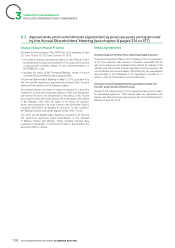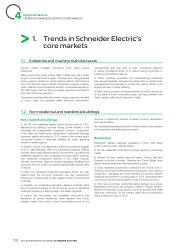APC 2015 Annual Report Download - page 174
Download and view the complete annual report
Please find page 174 of the 2015 APC annual report below. You can navigate through the pages in the report by either clicking on the pages listed below, or by using the keyword search tool below to find specific information within the annual report.
2015 REGISTRATION DOCUMENT SCHNEIDER ELECTRIC172
CORPORATE GOVERNANCE
3INTERNAL CONTROL AND RISK MANAGEMENT
promoted managers and units recently integrated. Operational
units, undertook self-assessment of compliance with the Key
Internal Controls governing their scope of operations.
The self-assessments conducted during the 2015 campaign
covered more than 90% of consolidated sales and made it possible
to defi ne improvement plans in the operating units, when necessary.
The ultimate goal is that these evaluations should cover at least
90% of consolidated sales each year.
The self-assessments are conducted in the units by each process
owner. Practices corresponding to the Key Internal Controls are
described and the entity is either compliant or not compliant to a
particular control.
If a particular unit is not compliant in any of the controls, an action
plan is defi ned and implemented to achieve compliance. These
action plans are listed in the self-assessment report.
The unit’s fi nancial manager conducts a critical review of the self-
assessments by process, and certifi es the quality of the overall
results. The self-evaluation is then also certifi ed by the person in
charge of the unit.
The regional internal controllers carried out controls on site to
assess the reliability of self-assessments and the effi ciency of the
remediation plans put in place as a result of the previous self-
assessment.
Global Functions
In 2015, the Global Functions continued to set guidelines, issue
instructions and provide support.
For example:
•in 2015, we have updated our ethical risk assessment matrix
and deployed it at the entity level while it was previously done
at country level. This matrix now integrates both internal and
external risk factors. External risks are based on internationally
recognized indexes on corruption, human rights abuses and
environmental pollution by countries. Internal risks are based
on the level of communication and implementation of company
policies and directives;
•the Security Department issued a comprehensive update of the
Global Travel Directive that enhances the rules to be compliant
with and that reinforces requirements in terms of Travel Security.
The Global Security Directive initially named « Internal Fraud
Fighting» was also totally updated and is now renamed «Internal
Fraud Investigation» with a focus on rules to be strictly applied
by internal investigators. The purpose is to be as professional as
we could be for this kind of potential sensitive actions, respectfull
of the Laws, and to avoid creating any new potential risk for the
Company in performing investigations;
•the Sustainable Development Department created a new
Corporate tool (named «Dora»– provided by «Global Navex»
an US based software company) used to store in the same place
all the Company corporate governance (Policies and Directives
concerning all domains). This tool allows an easyfi nding of any
existing rules the employees may need to fi nd and is specifi cally
designed to update& validate easily any piece of governance;
•certain policies have been created, updated and issued– Gifts&
Hospitality Policy, Business Agents, Policy;
•training on ethical topics continued for exposed functions &
entities with a specifi c focus on newly acquired companies.
Internal Control Department
Internal Controls Department continued to deploy the Key Internal
Controls–training and requests for self-assessments– throughout
the units, with the scope extended to cover new units.
New defi ciencies were identifi ed owing to additional Key Internal
Controls, which gave rise to further action plans.
Internal Control self-assessments results were reviewed, which
identifi ed areas needing work in 2016 as part of the process of
continuous improvement. In 2015, certain Key Internal Controls
were identifi ed as critical and actions will be taken to increase the
level of awareness and compliance.
The list of Key Internal Controls continues to evolve.
The software package for the management of self-assessment
questionnaires and follow-up action plans of Internal Audit and
Internal Control introduced in2011 continues to be improved.
The regional internal control organization introduced in 2011
consists of 29 regional internal controllers in fi ve regions, who:
•perform the duties defi ned under the section «Organization and
management: key participants of internal control– Internal Control
Department » for the units in their regional scope, covering all
Operational Departments;
•establish standardized procedures (e.g., for internal control
assignments, such as control cycles, documentation, scope
defi nition, work programs,etc.);
•completed more than 90 on-site inspection missions in2015 to
assess the level of internal control and the adequacy of action
plans, issuing the necessary recommendations when needed.
Internal Audit Department
The Internal Audit Department contributes to the analysis and to
strengthening the internal control system by:
•mapping general risks;
•verifying the effective application of Key Internal Controls during
audit assignments;
•reviewing the audited unit’s internal control self-assessment and
related action plans.
























